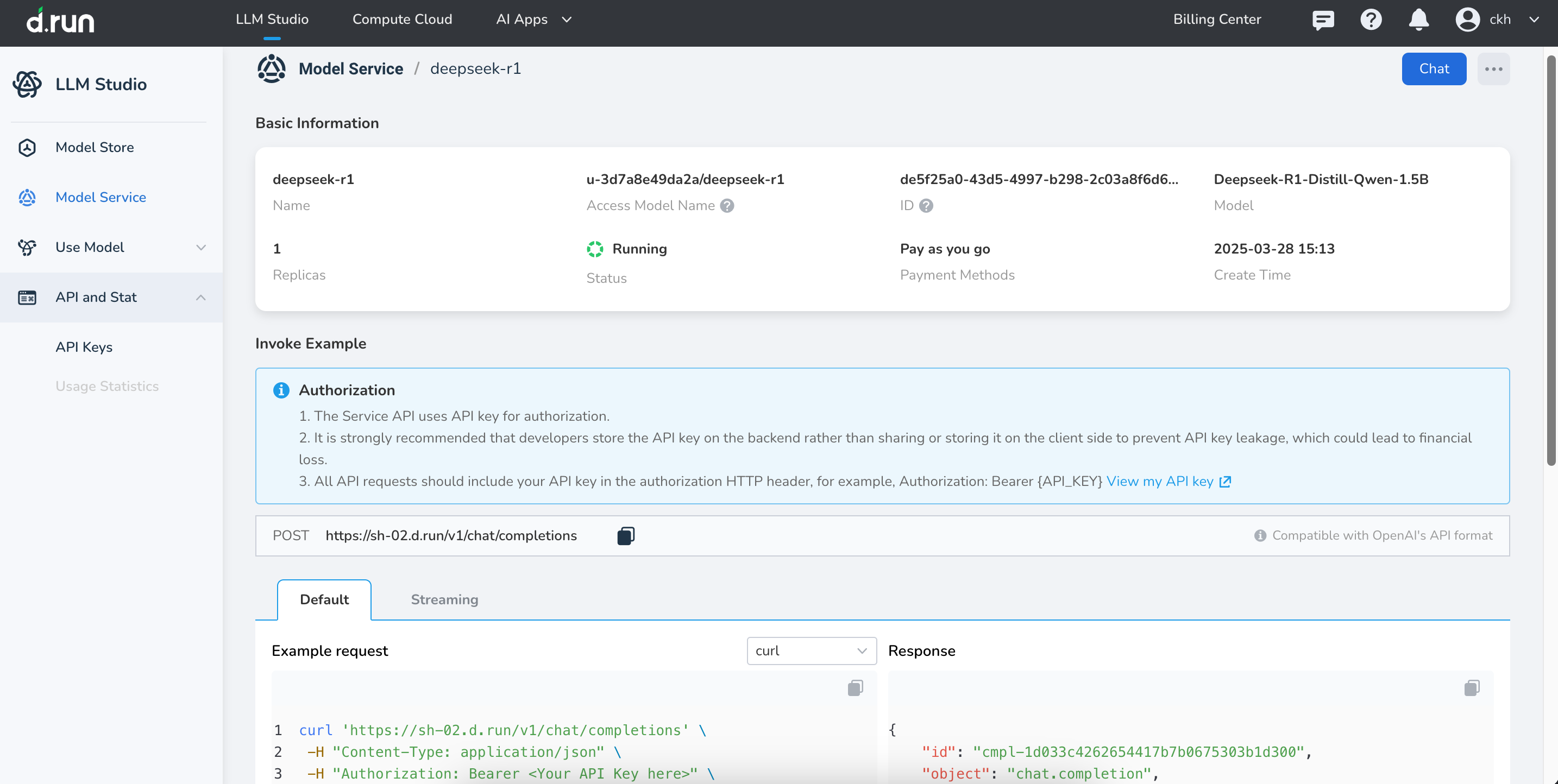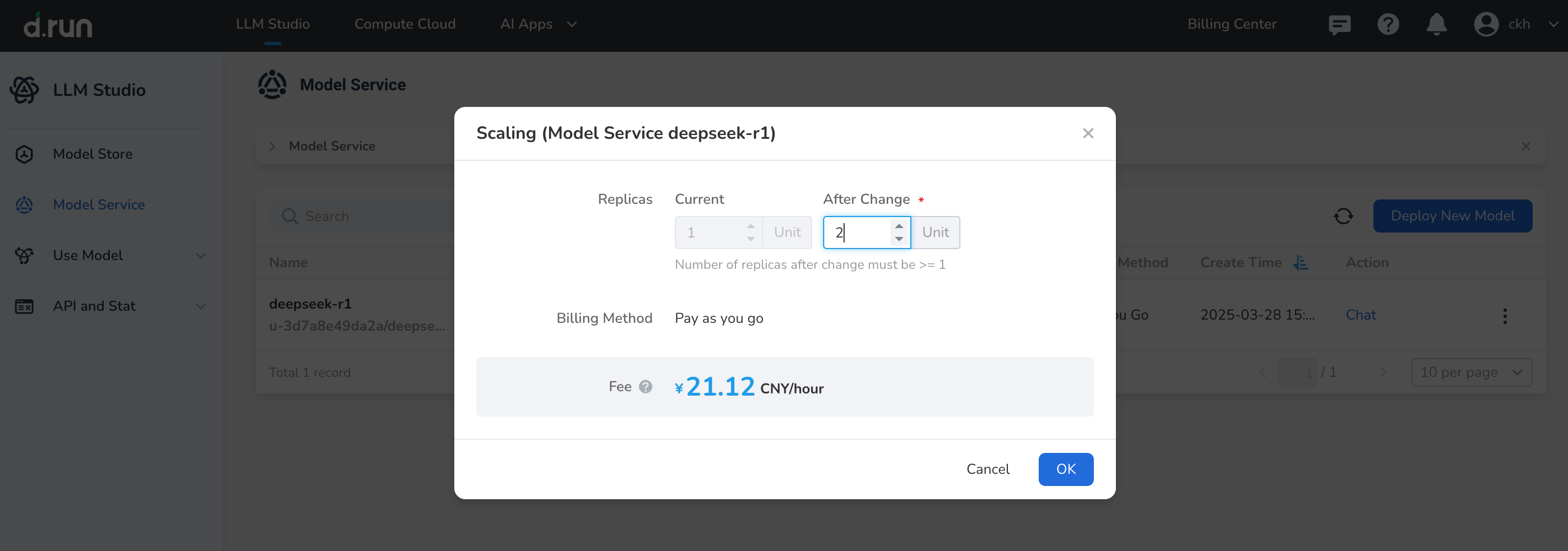Model Services¶
Model services provide a solution for quickly deploying open-source or fine-tuned large language models as callable services. With one-click deployment, the complex management of models is simplified into a standardized service format. This format is compatible with mainstream model service API call capabilities, enabling immediate use.
- Model services allow users to call selected models to perform tasks such as text generation, chat processing, image generation, and more.
- These services support the online experience of models.

The details of the model service include basic information about the service, available authorization methods, and example API calls.

Basic Information¶
- Model Service Name: The name of the service, used to identify this model service.
- Access Path Name: A unique path name for each model service.
- Model Type: The type of model used by the service.
- Status: The current operational status of the service.
- Billing Method: The billing method for the service.
Authorization Methods¶
API-Key Authorization¶
- All API requests require the inclusion of an
Authorizationfield in the HTTP header for identity verification. - Format:
Authorization: Bearer {API_KEY} - You can obtain your API key by clicking the "View My API-Key" link on the page.
Security Advice¶
- Store the API key securely on the backend server to prevent exposure in client-side code and avoid potential security leaks.
API Call Example¶
Request URL¶
The POST request URL is:
https://sh-02.d.run/v1/chat/completions
Request Example: Calling the API with curl¶
curl 'https://sh-02.d.run/v1/chat/completions' \
-H "Content-Type: application/json" \
-H "Authorization: Bearer <Your API Key here>" \
-d '{
"model": "u-8105f7322477/test",
"messages": [{"role": "user", "content": "Say this is a test!"}],
"temperature": 0.7
}'
Request Parameters:
- model: The access path name of the model service (e.g.,
u-8105f7322477/test). -
messages: A list of chat history containing user input, for example:
-
temperature: Controls the randomness of the generated output. A higher value produces more creative results, while a lower value yields more stable outputs.
Response Example¶
{
"id": "cmp-1d033c426254417b7b0675303b1d300",
"object": "chat.completion",
"created": 1733724462,
"model": "u-8105f7322477/test",
"choices": [
{
"index": 0,
"message": {
"role": "assistant",
"content": "I am a large language model. How can I assist you today?"
},
"tool_calls": []
}
],
"usage": {
"prompt_tokens": 25,
"completion_tokens": 15,
"total_tokens": 40
}
}
Response Fields:
- id: A unique identifier for the generated result.
- model: The ID of the model service being called.
- choices: An array of results generated by the model.
- message: The generated content.
- content: The text content produced by the model.
- usage: Token usage for this call:
- prompt_tokens: The number of tokens used for the user input.
- completion_tokens: The number of tokens used for the generated response.
- total_tokens: The total token usage.
Python Example¶
# Compatible with OpenAI Python library v1.0.0 and above
from openai import OpenAI
client = OpenAI(
base_url="https://sh-02.d.run/v1/",
api_key="<Your API Key here>"
)
messages = [
{"role": "user", "content": "hello!"},
{"role": "user", "content": "Say this is a test?"}
]
response = client.chat.completions.create(
model="u-8105f7322477/test",
messages=messages
)
content = response.choices[0].message.content
print(content)
Node.js Example¶
const OpenAI = require('openai');
const openai = new OpenAI({
baseURL: 'https://sh-02.d.run/v1',
apiKey: '<Your API Key here>',
});
async function getData() {
try {
const chatCompletion = await openai.chat.completions.create({
model: 'u-8105f7322477/test',
messages: [
{ role: 'user', content: 'hello!' },
{ role: 'user', content: 'how are you?' },
],
});
console.log(chatCompletion.choices[0].message.content);
} catch (error) {
if (error instanceof OpenAI.APIError) {
console.error('API Error:', error.status, error.message);
console.error('Error details:', error.error);
} else {
console.error('Unexpected error:', error);
}
}
}
getData();
Scaling Up and Down¶
If you experience resource shortages or lag while using the model, you can scale up the model.
In the model service list, click ┇ on the right side, then select Scale Up/Down from the dropdown menu.

Enter the number of instances you want to add, such as 2, and click OK .

Deletion¶
- In the model service list, click ┇ on the right side, then select Delete from the dropdown menu.
- Enter the name of the model to be deleted, verify the details, and click Delete.

Caution
Once deleted, the model will stop running, and billing will cease.